Production Site: The Artist’s Studio Inside-Out at the MCA
By Whitney Stoepel
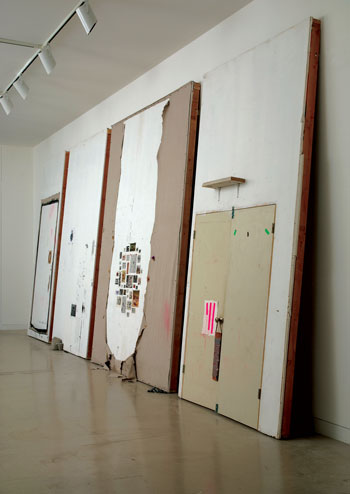
The complex and poetic role of the studio in an artist’s life and work is explored in “Production Site: The Artist’s Studio Inside-Out,” which opened February 6 at the Museum of Contemporary Art (MCA) and closes May 30.
This exhibition is part of Studio Chicago, an ongoing collaborative project that began in October of 2009. This enormous, year-long project involves the city’s major cultural players, including SAIC, the Chicago Department of Cultural Affairs, Columbia College Chicago, DePaul University, Gallery 400 at UIC, Hyde Park Art Center, the Museum of Contemporary Art and threewalls.
According to studiochicago.org, the project hopes to engage Chicago artists, the Chicago “art-curious” and the international art community in a year-long exploration of questions around the definition of the artist’s studio in the 21st century. Programs and exhibitions ask: How and why does the studio matter to art and artists today? What is the artist’s studio today? What infrastructure is needed to sustain thriving art practice, and what role does the studio play within this infrastructure? What Studio Chicago’s organizers fail to question, however, is how relevant this question even is for 2010; after all, avant-garde artists have been questioning, challenging and destroying the romantic myth of the studio since at least the mid-20th century.
This question of relevance is problematic at the MCA, where “Production Site” curator Dominic Molon rather unimaginatively asks why there is a need to focus on the artist’s studio when a dedicated physical space is becoming less necessary in the “age of the iPhone.” Molon is particularly interested in depicting the significant shift occurring in the art world during the present state of economic duress, and how production may change in a time when consumption isn’t guaranteed. The curator is also interested in engaging with traditional ideas of the studio as an incredibly personal space, in which artists experience some of their most profound and devastating moments, a place where success is born and disappointing projects are discarded.
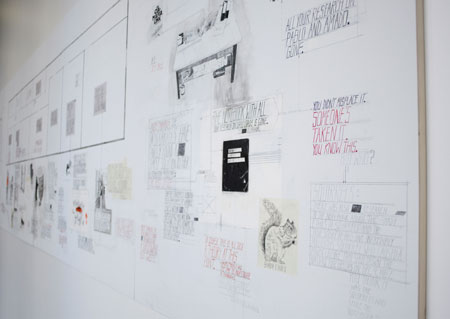
Fortunately for the success of the exhibition, each of the 13 represented artists answers this less than challenging question in intriguing and productive ways. This diverse show includes international and Chicago-based artists, preeminent veterans and up-and-comers. The main second floor gallery begins with local emerging artist and UBS 12×12 alum Deb Sokolow’s 5-part acrylic on wood, “You Tell People You’re Working Really Hard On Things These Days.” This large piece tells the story of her studio and the neighborhood surrounding it using line-drawn maps and blueprints, illustrations, and some tongue-in-cheek anecdotes. As the stories change, so will the work—Sokolow will return once a week to update the piece, transforming the gallery into a sort-of studio.
Alabama-born and Chicago-based painter Kerry James Marshall has eight pieces on display, including some preparatory drawings of the kind usually thrown out after a completed painting. Marshall is known for his strong and eloquent statements on African-American culture, and “Untitled (Painter)” continues in this vein of inquiry in its depiction of a black woman artist in her studio completing a paint-by-number composition. Molon cites this piece as Marshall’s response to female Kenyan artist Wangechi Mutu, who herself was inspired by a photo of black artist Carrie Mae Weems in her studio.
Marshall combines traditional and contemporary styles to hint at changing notions of African-American identity throughout history, and engages with the struggle of female artists as well. The woman in “Untitled (Painter)” is depicted in the style of the French Rococo, reminiscent of self-portraits by Élisabeth-Louise Vigeé-Le Brun, but her ears are lined with gold hoops, and the use of the Warhol-esque paint-by-number references add a pop aesthetic.
Accompanying this work is “Black Artist (Studio View),” a photo of Marshall in his studio taken under a black light, and “7am Sunday Morning,” a large painting that depicts the view from Marshall’s studio on the South Side.
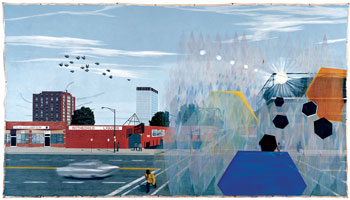
Nikhil Chopra engages with the exhibition’s theme in a radically different way: he has no studio. Hailing from the overpopulated city of Mumbai where work space is scarce, Chopra believes, “The studio is where I am.” Performance is central to his work, and his piece for the MCA became the documentation of a 16-hour performance titled “Yog Raj Chitrakar: Memory Drawing XI.”
Before Chopra’s performance in the space at MCA on February 10, the room was painted a pale blue and littered with only a few artifacts, including a ladder, chair, some silver bowls and a small broom (the appearance of the room will evolve throughout the exhibition). Chopra invites the viewers to act like “forensic scientists,” imagining what happened in the space before they arrived.
While Chopra chooses to forgo a formal documentation process, others in the show, like William Kentridge and Bruce Nauman, employ the use of film and video to document their studios. Taking place in separate rooms and displayed on multiple screens, Kentridge is shown toying with and sketching charcoal drawings within his studio, while Nauman films his studio with infrared light after the work has been finished and shipped off. The only remnants of life are a cat and the occasional rat flitting by.
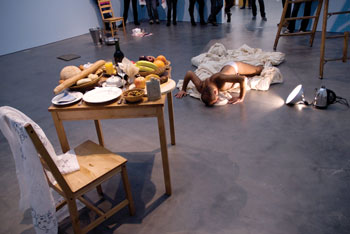
Amanda Ross-Ho created the most literal interpretation of the theme by removing the walls of her studio and replanting them in the MCA, entry door and all. This is the second time “Frauds for an Inside Job” has been exhibited, and it is mesmerizing. Eye-catching graphic elements like a Notorious BIG poster immediately grab the viewer’s attention. As one spends more time with the installation, however, more subtle details begin to emerge, like a phone number scrawled in pencil on the wall.
Like many of the other artists, Ross-Ho wants the audience to ponder what might have happened in this space, which she occupied for nine years. An intriguing struggle Ross-Ho deals with is the inevitable loss of translation between studio and gallery; the artist hopes the walls might “absorb the production energy” from her studio and carry that to the gallery space. Other artists featured in the exhibition are Justin Cooper, Tacita Dean, Fischli/Weiss, Ryan Gander, Rodney Graham, John Neff and Andrea Zittel.
“Production Site” is successful in that it prioritizes strong visuals and aesthetic experience over an academic investigation of the artist’s intimate work space, although a slightly voyeuristic tone is problematic. It remains to be seen, however, whether future iterations of the Studio Chicago project will be as successful.




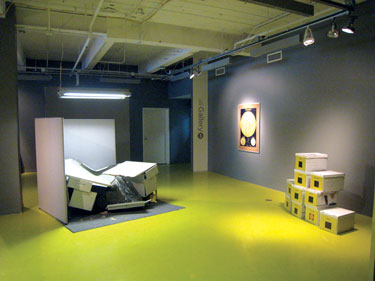



[…] notes a past gallery project called Production Site: The Artist’s Studio Inside – Out which dealt with such questions […]
[…] notes a past gallery project called Production Site: The Artist’s Studio Inside – Out which dealt with such questions […]